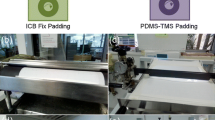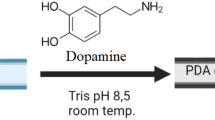Abstract
This paper describes the surface functionalization of woven silk fabric by magnetron sputter coating of PTFE (polytetrafluoroethylene). The PTFE sputter coating was applied to improve the hydrophobic property of silk fabric. The effects of PTFE sputter coating on surface morphology and surface chemical properties were characterized using atomic force microscopy (AFM) and ATR-FTIR (attenuated total reflection-Fourier transform infrared spectroscopy). The wettability of the fabric was characterized through measuring the surface contact angle by a dynamic sessile analysis (DSA) technique. The contact angle of the PTFE coated fabric showed a significant increase from 68° to about 138°. The experimental results also revealed that larger sputtering pressures brought less contact angle hysteresis.
Similar content being viewed by others
Explore related subjects
Discover the latest articles, news and stories from top researchers in related subjects.Avoid common mistakes on your manuscript.
Introduction
Silk has been used in textile industries for many centuries due to its superior properties. Cultivated silk is a beautiful luxurious fiber with a smooth luxurious hand. This type of silk can be dyed and printed in bright colors. Silk fabrics have good absorbency. However, with a variety of chemical fibers overwhelming the textile industries, silk’s status has been gradually challenged. Therefore modifying the properties of silk and expanding its new uses have attracted great attention in the world.
In the textile and other industries, there has been a continuous demand for water-repellent or hydrophobic coatings, especially for super-hydrophobic coatings which present water contact angles greater than 120°. Wettability of solid surfaces with water is known to be influenced by two main factors, i.e., surface chemistry and surface topography [1, 2].
In recent years, the use of plasma vapour deposition (PVD) [3] to modify surface properties of materials has experienced rapid growth. PVD is a process by which a thin film of material is deposited on a substrate. One of the most promising techniques in PVD technology is sputtering, which has been widely used to modify various materials in many industries. Therefore, sputter coating was used in this study to deposit polytetrafluoroethylene (PTFE) on one side of silk fabric for improving the hydrophobic property of the material. Silk fabric with water-repellent properties has great potential in stain-free textile products.
Experimental
Materials preparation
The sample used in this study was silk twill fabric with a mass of 36 m/m (145 g/m2).
The deposition was performed in a JZCK-420B magnetron sputtering arrangement including a molecular vacuum pump, RF power source and a control unit. A pure sputtering target (99.99%) of PTFE mounted on the cathode and argon, 99.99% purity as the bombardment gas, were used in this study. The substrate and quartz crystal monitor were located 100 mm from the magnetron. Different pressures were adopted to investigate the shape and structures of PTFE nano-particles formed on the fiber. The sputter coating was performed 90 min for each sample.
Surface characterization
Topographic observation was performed employing a Benyuan CSPM-400 atomic force microscopy (AFM) which is one of the most effective tools to examine the microstructures of materials. It is able to scan materials without any special preparation at normal temperature and pressure [4]. In this study, the scanning mode used was contact mode.
Wettability was measured using sessile drop observations and the Wilhelmy technique, which are two major methods of contact angle measurement. The first method is often a static contact angle measurement, while the Wilhelmy technique can obtain the results of both advancing and receding contact angles and hence contact angle hysteresis. In this study, DSA100 apparatus produced by KRUSS company was employed to measure the static contact angle, and CDCA-100F was used in dynamic contact angle and hysteresis measurement.
The surface chemistry of the fabric was examined by Fourier Transform Infra Red (FTIR) spectroscopy. Spectra were recorded in air by use of a FTIR Nexus spectrometer. The analysis software used was Omnic 5.2 provided by Thermo Nicolet. Spectra were corrected for H2O and CO2 content in the optical path. The spectral resolution was 4 cm−1.
Results and discussion
It is well known that surface chemistry is one of the key factors affecting a material’s wettability [1]. Fluoride is one of the most commonly used substances to improve the hydrophobicity of solid materials [5].
Surface chemical
The FTIR spectrum of the silk fabric, sputtered with PTFE at 2 Pa pressure in argon is shown in Fig. 1. This spectrum shows the PTFE character on the fabric surface compared to the spectrum for the original fabric in Fig. 2. The main absorption band situated at about 1400–1100 cm−1 is composed of the two peaks at 1290 and 1172 cm−1 with a shoulder at about 1150 cm−1,while the spectrum of PTFE block has two peaks at 1228 and 1157 cm−1, which can be attributed to the different C–F structure between sputtered film and block of PTFE [6]. As shown in Fig. 1, the width of the stretching vibration peak of C–F on the sputtered PTFE film is wider than that of PTFE blocks, and also the polarity of C–F is altered because of the contact between CF4 and silk. The two peaks in the non-crystal zone and crystal zone, with equal intensity at 641 and 528 cm−1 reflect the crystallinity of the sputtered PTFE film. From this result, it can be concluded that the sputtered PTFE film has low crystallinity.
Since free radicals caused by Ar+ sputtering would unit into new bonds, some new absorbance peaks occur in the spectrum. An important band of deformation vibrations of CF3 groups can be observed at 731 cm−1.
Surface morphology
AFM investigation reveals that the roughness of PTFE films generally increases with the working gas pressure. A smooth surface with clear fibril structures is observed for the original fiber, as illustrated in Fig. 3a. Figure 3b shows the rough surface of the PTFE sputtered fiber. The PTFE aggregates with an average diameter of 36 nm are formed on the fiber surface where the sputtering was performed at a pressure of 2 Pa. As the pressure is increased to 50 Pa, larger PTFE aggregates are deposited on the fiber surface, as indicated in Fig. 3c. The diameter of the sputtered PTFE particles reaches 350 nm. The trend of roughness with the pressure constant increasing is shown in Fig. 4. The higher argon pressure increases the number of collisions, which causes higher ionization efficiency and higher plasma density. This may be the main reason for the roughness increase with pressure.
Contact angles and hysteresis
The results of the static contact angle measurements are listed in Table 1. It clearly shows that PTFE sputter coating significantly increases the surface contact angle of the silk fabric. The static contact angle is increased to 134° for the fabric sputtered at 5 Pa from 63° for the original one. The table also indicates that working pressure has little effect on the static contact angle of the fabric. This is attributed to the formation of stable chemical structures on the fabric surface after PTFE sputter coating.
The image in Fig. 5 shows a water droplet formed on the PTFE sputter coated silk fabric. The high contact angle in the image clearly reveals the hydrophobic behaviour of the PTFE sputter coated fabric.
Contact angle hysteresis is significantly influenced by the surface wetting behaviour of a material. Static contact angle measurements, however, do not give any information on contact angle hysteresis. Contact angle hystersis is revealed by dynamic contact angle measurement using CDCA-100F, as displayed in Fig. 6. The values obtained by this technique show a little difference from those obtained by sessile drop test. This can be attributed to fabric’s particular texture structure. As shown in Fig. 6, the advancing contact angle changes from 110° to 129°, while receding contact angle increases from 84° to 123° as the argon pressure is constantly increased from 5 Pa to 50 Pa. The diagram in Fig. 6 shows an obvious decrease in contact hysteresis as the working pressure is increased. The surface roughness contributes to the change in contact angle hystersis.
Conclusions
Improvement in the hydrophobicity of silk fabric was achieved using PTFE magnetron sputter coating. This study has revealed that PTFE sputter coating can considerably increase the contact angles and significantly improve the hydrophobicity of silk fabric. FTIR spectra revealed the chemical compositions on the fabric surface before and after PTFE sputter coating. AFM observations have revealed the increase in surface roughness with working pressure. The hysteresis of contact angle can be reduced by adjusting working pressure.
References
Shibuichi S, Yamamoto T, Onda T (1998) J Colloid Interface Sci 1:287
Jiang L, Wang R, Yang B (2000) Pure Appl Chem 72:73
Kuhr M, Bauer S, Rothhaar U (2003) Thin Solid Films 442:107
Wei QF (2004) Mater Charact 52:231
Biederman H (1981) Vacuum 31:285
Zhu KG, Shi JZ, Li KB (1997) Chin Phys Soc 9:1764
Acknowledgment
This research was supported by the Program for New Century Excellent Talents in University (NCET-06-0485) and the Key Laboratory of Textile Materials, Anhui University of Technology and Science (No. 2006FZ002) and the Open Project Program of Key Laboratory of Eco-Textiles (Southern Yangtze University), Ministry of Education, China (No. KLET0613).
Author information
Authors and Affiliations
Corresponding author
Rights and permissions
About this article
Cite this article
Huang, F., Wei, Q., Liu, Y. et al. Surface functionalization of silk fabric by PTFE sputter coating. J Mater Sci 42, 8025–8028 (2007). https://doi.org/10.1007/s10853-007-1580-3
Received:
Accepted:
Published:
Issue Date:
DOI: https://doi.org/10.1007/s10853-007-1580-3










